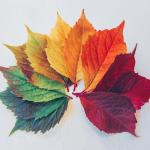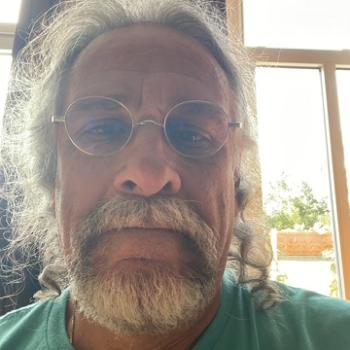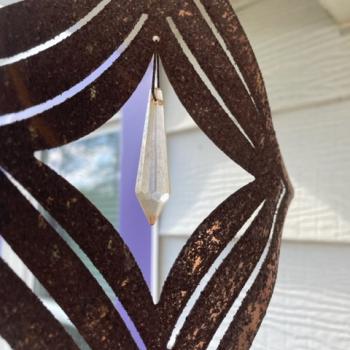Beliefs
The Indo-Europeans and their descendants were patriarchal. I don’t think there ever was a completely unbigoted culture ever in history. As long as people cling to fear, misconception, and untruths, there never will be. But our local cosmos can have as much fairness in it as we’d like it to have. And so, though the domestic cult traditionally favors the male head of the household, our modern feminism can inform our reconstructions. This way we can benefit from our ancestors’ faith, as well as modernity. So, in some households, like the Brehon Laws state, “The woman goes into the place of the man and the man into the place of a woman.”
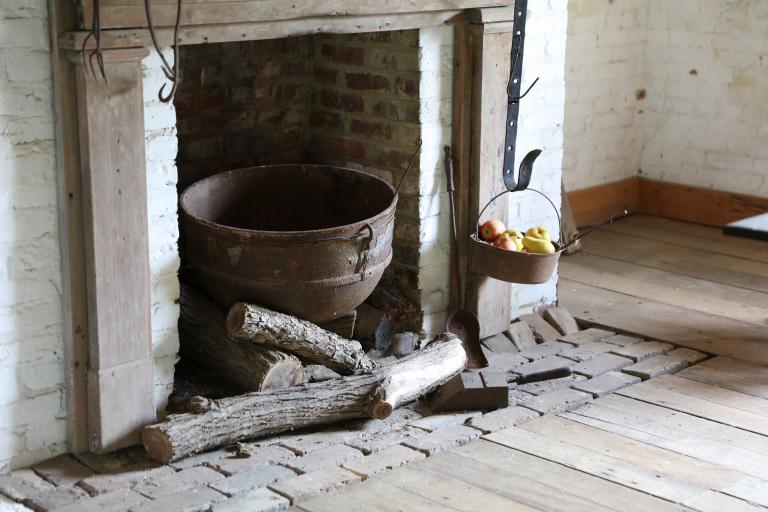
My wife is the chief of the local Celtic pagan grove to which I belong. As the person elected as the sovereign of the group, she performs the role of the male in our domestic cult. While we maintain the roles of householder and hearthkeeper, those roles have become genderless for us. I have a patronage contract with Brighid so it is more appropriate for us to reverse the roles.
The domestic cult is centered around a few things: certain beliefs, certain activities, performed by certain roles. The Gaelic hearth goddess, and later saint worshiped at the hearth, is named Brighid. She is the central figure of the domestic cult. My grove uses her in our Local cultus. Our grove is called HearthStone Grove, Doire leac an Teallaigh. We see ourselves as a clan of families, a larger family. Our ‘regional difference’ from other recon groups and other ADF groves is that our group practice is extremely informed by our domestic cult.
Ceisiwr Serith points out that the family was first, then the clan was second, and societal religion arose out of the domestic religion. He reiterates Angela Della Volpe’s conclusion that “each Indo-European family had its own religion” (Serith 95). So we can say this about each family and tuath in Gaelic pagandom.
In our group, we honor Brighid as the god of our sacrificial fires as we do in our domestic fires. The only difference between clan and domestic is that Brighid is fire Tender of the stately or group fire, while Brighid is directly the Domestic fire herself. Dagda is the group ritual fire, and he is tended by his daughter. Brighid is the foster mother of Christ as a saint, and she is the Cow goddess counterpart to the Mare goddess in Ceisiwr Serith’s assessment in Deep Ancestors through her functionality(Serith 62).
Righ(India: Raj) means is the king, and Brig means High or Exalted. You can see a similar connection in the names of other sovereigns when you consider Brigantia(i.e. Rigan as in Morrigan). That doesn’t mean they’re related but deserves investigation. In fact, she is potentially connected somehow with the Morrigan through the Bean Sidhe and Keening. Although the two goddesses have dealings, they are independent. As wife to Bres, she was Queen of the gods at one point, but Bres was driven off and since, Brighid has been seen as without a consort, and without children.
As a Noblewoman, and a landowning lady, she encapsulates the ideas surrounding land claiming. Kindling a hearthfire was an act of legal land claiming, and Brigid’s virgins remain childless and husbandless so that the land ownership of the temple can remain under the control of a female of the nemed class: her priestesses. No men were allowed beyond the hedge that enclosed her fire(Serith 73,114). So there are potentially two cow goddesses, quintessentially the cow like Boand, and a goddess of sovereignty over cows, like Brighid who is midwife to all things that birth and therefore cows.
She is accompanied by a white cow with red ears, further connecting her with both sovereignty and the Morrigan. She is also given milk and is the goddess of milk, while the festival of the return of milk is given in her honor. Therefore, she is a god of domestic qualities and domestic production, as well as the farm.
The Carmina Gadelica says, “Bride is said to preside over fire, over art, over all beauty, ‘fo cheabhar agus fo chuan,’ beneath the sky and beneath the sea.”, and Bride is called by midwives for aid in childbirth.
The Gaels, like any pastoral Indo-European society, fed their summer cattle on the moors and mountains. The cattle and their tenders were healthier (Danaher 30, 2004). The people out to Summer pasture would churn butter and milk the cows. They would live in huts dug out of the hills kind of like three walled longhouses. Back home the grasses would get thick and provide for the winter hay stock. This way, cattle ranchers could get make more profit.
To imitate this in remembrance of the old ways, we offer to the empty bowl next to the lamp which are then left at a window sill or outside, or are burned immediately on the hearth fire. However, you can, in the summer put your offerings directly into the hearth fire.
As we have mentioned, Samos and Giamos are alternating summer and winter currents. They are light and dark, night and day, cold and hot, old and new. Ultimately they are the forces of the universe as ordered or chaotic.
Samos enters our home through the fire, which is lit by the fire of the local cult on Samhain and at Bealtaine. When the fire goes out you borrow fire from another sovereign hearth, except on the witch days(11th of every fire festival month), May Day, or Samhain. It is unlucky to borrow fire on those days. Giamos enters our home in pails of water for drinking, washing, or in modern plumbing.
In Proto-Indo-European reconstructions, Ptr and Mtr lead the roles of Householder and Hearthkeeper. As feminists, we don’t have to follow these roles. You can slot them with whoever in the family is inclined or skilled to do those tasks. You can take turns in your family by switching tasks, either based on summer and winter transhumance or another pattern you choose. Or you have the more magically inclined person do all of it. Back in Proto-Indo-European domestic rites, the father of the immediate household would lead the rites to the household gods. The mother would tend the lamp, fire, and lead the ancestral rites.
Our rites are simple rites. But they encapsulate the two powers. The Pot or Bowl is sympathetically linked with the Well of Potential(Segais) from which all things spring. And so whether it is Pot and Hearth or Bowl and Flame. And so we have Samos and Giamos linked and alternating in the home.
Primary worship is given to the goddess of fire and the hearth Brighid, to Lugh, to Nuada, and to Dagda. This is based on the Ceisiwr Serith’s Deep Ancestors Domestic Cult and Dumezilian Tripartition model plus Dumezil’s essay on Mitra-Varuna and first gods and last gods. Gods from the top three functions are honored. The Varuna-Mitra complex is best represented by Dagda-Nuada. Varuna, a king of magic, and Mitra, a king of military alliances and oaths can relate best to Dagda through magic and Nuada through Justice.
Ceisiwr has Dyeus Ptr, Perkwunos, and Westia in the Proto-Indo-European domestic practice. And this work is mostly scaffolded onto his skeleton. I’ve added Nuada based on Dumezil. Nuada can be seen as a reflex of Deiwos as much as Dag Dewos is. And though Dagda is a Striker through one of his names and his club, and because he has a cauldron and harp he is transfunctional, Perkwunos, the lightning wielder is clearly Lugh, since he holds the spear whose name bolgos means both speak and lightning. Alexei believes that Lugh is a storm god as well, though he places Dagda as a Third functional deity.
Ancestor worship is just as important as deity worship. There are two rites that should be done weekly. And one rite that is just about them, Samhain.
The householder is the priest, hearthkeeper is the priestess. The Householder’s regular duties include prayer with or on behalf of the family.
Family members do their own individual rites. This usually grows naturally out of the domestic cult and can’t really be written about. Children take what works for them and use it. You should develop this as well.
Equipment
At the minimum, you will need a lamp, two bowls, and two dishes. The first dish is a fire safe dish in which you can burn a single lump of coal. If you cannot have a fire or cook where you live, it is not a place fit for the practice of a domestic cult. However, a Traveler’s cult might be better for such situations. Ideally, instead of a dish with a lump of coal, this is a hearth.
The second dish is for keeping offerings before they’re given. It can be a dish or bowl. The first bowl is for holding water. The second bowl is for placing offerings into after they’re given. Sympathetically, this bowl represents the domicile of the gods to whom you’re offering. You can choose to see it as a coracle that we are sending to the realm of the gods. But it is an enclosure that is not our own, but is self-similar to our own and represents the reception point of the divinity.
We have our stove, which if is electric instead of gas or propane, cannot use the fire to cook food. But butane or propane stoves are easy to come by at the camping store and we can use them infrequently during our regular rites. Keep the lamp of the Hearth goddess next to stove or hearth. We cook food with the stove which is lit from the lamp, which is lit from the hearth. Our food has Brighid’s flame in it and we offer that back into the Hearth. This way, the gifting cycle is held complete.
Rites
Deity rite
1. Put the bowl of water in the west.
2. Put the lamp in the east or to the east of the stove.
3. Put the empty bowl by it.
4. Put a full dish of offerings in the center. For the deity rite, this should be a bowl of alcohol.
5. The hearth is where the hearth is, but if using coal, put it also in the center of the working space.
6. Presumably, the hearth is lit. If using coal, prelight it and begin when it is red hot.
7. Dip your hand in the water bowl in the west. Touch forehead saying:
Let me be pure so I may part the sacred mists.
8. Dip again and touch lips saying:
Let me span the mists and enter the holy.
9. Dip again and touch heart saying:
Let me enter the holy that I might receive the blessings of the gods.
10. Go out onto the porch with hands on the door jambs saying out into the darkness:
Brighid! Brighid! come in,
Your welcome is truly made
Give your blessings to the family,
And give conception to the Fire.
Bí istigh ionainn!(Be within us!)
11. Have the person acting as Hearthkeeper sprinkle some herbs on the coal so that it will flame up.
12. Have that same person offer to Brighid
13. They light the lamp from the coal or from the hearth. Use a firestick or incense to transfer it if need be. Be safe and use tongues. Don’t burn yourself. If you have a gas hearth, you make consider just burning wood in it. If that isn’t an option, get creative and grow your own practice into your situation.
14. Once the lamp is lit, they say:
Brighid is here, the Hearth of our home.
15. The person acting as Housholder says:
The Sea surrounds us,
The Land upholds us,
While the Sky embraces us,
Our family is at the center as a living fire.
We pray that we are blessed if our rite be done in beauty and truth.
Blessings, and honor, and worship to the Holy Ones.
16. Then offerings are made to the main gods with them saying:
I pray to the gods which my ancestors worshiped
Without reservation,
Omitting none,
Forgetting none,
Forbidding none.
Let na nDéithe receive my blessings,
Hear my voice and my poetry,
May all the gods pour forward their blessings,
Sending forth their gifts and love,
To those who dwell here,
To all for whom I speak.
Éistigí anois, le háit na na ndéithe seo
(AYSH-ti-gee uh-NISH, le hawtch nuh NAY-heh shuh ‘Listen now to this place of gods’)
17. They then do some form of prostration and says:
Dagda Mor, Nuada Necht
Lugh Lamhfada, mighty defenders,
May this home be orderly and peaceful, well-built and protected, blessed by the gifts the gods bestow.
I call to you as my kin, join in my magic, meet me at the fire, and accept our offerings.
Bígí istigh ionainn!(Be within us!: addressing multiple parties changes bí into bígí)
Bíodh sé amhlaidh!
18. Make three pours into the empty bowl.
19. Honor other gods of the family, honor the tutelary deity to which the family belongs or the deities to which the other family members pray making a pour for each.
20. Bowing to the fire, Hearthkeeper puts it out and the rite is done.
“But wait, Dagda and Nuada aren’t very ‘domestic’”. A common way to see things in paganism with modern eyes is to view the domestic rites as rites of domesticity. But instead, domestic rites are about the domicile’s position and relation to the rest of the cosmos. Thus we need to also honor the chief gods in the domestic deity rite, not just gods of the hearth.
This rite is to be done weekly on the same day of the week.
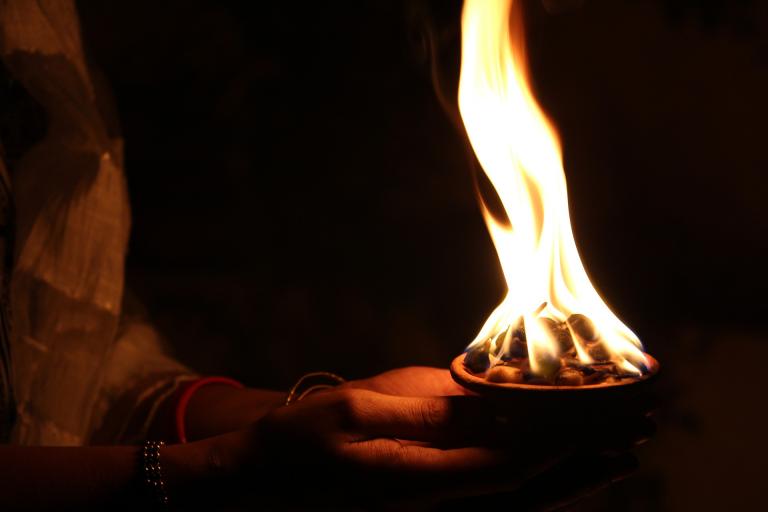
Ancestors’ rite
1. Hearthkeeper does all the parts.
2. Put the bowl of water in the west.
3. Put the lamp in the east or to the east of the stove.
4. Put the empty bowl by it.
5. Put a full dish of offerings in the center. For the ancestor’s rite, this should be a bowl of food(leftover from dinner or cooked for them) and a cup with a drink.
6. The hearth is where the hearth is, but if using coal, put it also in the center of the working space.
7. Presumably, the hearth is lit. If using coal, prelight it and begin when it is red hot.
8. Dip your hand in the water bowl in the west. Touch forehead saying:
Let me be pure so I may part the sacred mists.
9. Dip again and touch lips saying:
Let me span the entire mists and enter the holy.
10. Dip again and touch heart saying:
Let me enter the holy that I might receive the blessings of the gods.
11. Go out onto the porch with hands on the door jambs saying out into the darkness:
Brighid! Brighid! come in,
Your welcome is truly made
Give your blessings to the family,
And give conception to the Fire.
Bí istigh ionainn!(Be within us!)
12. Sprinkle some herbs on the coal so that it will flame up.
13. Light the lamp from the coal or from the hearth. Again, Be safe.
14. Once the lamp is lit, say:
Brighid is here, the Hearth of our home.
15. Offer food and milk, cream, butter, or oil to Brighid.
16. Then say:
The Sea surrounds ,
The Land upholds us,
While the Sky embraces us,
And we stand at the center as a living fire.
We pray that we are blessed if our rite be done in beauty and truth.
Blessings, and honor, and worship to the Holy Ones.
17. Then food and drink offerings are made to the ancestors saying:
I pray to the ancestors who worshiped my gods,
To the First and Founders of my kin, I pray,
I pray to the Mothers and the Fathers,
To the Grandmothers and Fathers, I pray,
We call to you, our kin,
To join us in our magic,
Meet us at the boundary,
And accept our offering.
To you, we give our thanks,
Help us thrive in our wealth,
Counsel and comfort us,
Uphold and hallow us.
Éistigí anois, le háit na sinsear seo (Listen now to this place of elders.
AYSH-tih-gee uh-NISH, le hawtch nuh SHIN-shur shuh)
18. They then does some form of prostration and says:
[List of names and attributes of ancestors]
May this home be orderly and peaceful, well-built and protected, blessed by the gifts the ancestors bestow.
I call to you my kin, join in my magic, meet me at the fire, and accept our offerings.
Bígí istigh ionainn!(Be within us!: addressing multiple beings changes bí into bígí
BeeGEE esh-TUH ANN-un))
Bíodh sé amhlaidh!(So be it
BEEog shay owlLEE)
19. Make pours into the empty bowl, one for each ancestor.
20. Honor other dead of the family such as favorite legendary or national heroes. Let the family members speak to the dead and take omens of their responses.
21. Bowing to the fire, they put it out and the rite is done.
This rite is done weekly on the same day of the week at any time. Our modern schedules are not the agricultural and pastoral schedules of our ancestors. You can do it at one of the liminal times as well.
Regular Practices
Flame Lighting Rite
Light the lamp daily saying whatever words come to mind. This is done daily. You can ask Brighid to come in every day at the door jambs, but you may not want to holler a charm out of your house daily.
Smooring the Hearthfire
In ancient days, hearth fires were not put out. They were smoored down to coals with prayers and then rekindled in the morning with fuel. Prayers are to be said when the fire is either smoored or kindled. Smooring the fire is an act of breaking down the fire so that all flames disappear and only coals remain. Afterward rake the coals together so they stay lit through the night. You can do this saying:
Brighid at the head,
Boand at the foot,
Burning be confined,
Binding the soot.
While saying these, make the sign of Brigid’s cross(north-south, east to west) over the fire with the tongues. In the morning, the fire can have logs of wood or peat put on it and be rekindled for breakfast. This can be done saying:
Brighid at the head,
Boand at the foot,
Back to new life,
Kindled with wood.
Occasional practices
Bealtaine & Samhain
At Bealtaine and Samhain, we rekindle the hearth or light coal from the sovereignty fire of our group. We carry the coals from that fire into our hearths in carved turnips or pumpkins called Jack-O-Lanterns.
If you don’t have a group you can kindle your own sovereignty fire outside on a hill, after you’ve established the sacred center, and you can carry the coals back to your hearth. Be careful if driving with the coals. Keep them in a fire safe container and don’t leave the windows up because coals give off noxious and poisonous gasses. One of the fire festivals should be solely about Ancestor worship. This is for Gaels, Samhain, and Martinmas.
Imbolc
You should have one of your four or eight fire festivals be in honor of the hearth goddess. For Gaels this is Imbolc. I won’t discuss the Imbolc rite here, however, I should mention that it is part of the domestic cult to have the hearth goddess be honored all on her own, usually in springtime in the northern hemisphere. This is just like the Ancestors getting their own honor at a festival dedicated to them.
Nature wild transformation – > apotropaic amulet: Rowan or Brigid crosses
Buying and Selling a Home
When you buy or sell a home, you want to do a few things that you don’t regularly do. After receiving an offer, if you want to get it to close faster, walk around your home counter-clockwise and say close three times carrying the lamp. If you’re not getting any offers, find an empty birds nest and put some honey on a piece of bread and leave it out by a tree until it closes.
When buying a home, walk around the house three times clockwise after closing carrying the lamp you intend to use as your hearth lamp. Put iron at the corners, but especially in the west corners. You can suffumigation the places while singing songs or saying charms. Burn bunches of dried juniper. Don’t use sage, and don’t call it a smudge, that’s not Gaelic culture. You can regularly suffumigate the house. Remember, the spirits are people, if it smells bad, bad spirits are attracted. If it smells pleasant, good spirits are attracted. Renew these wards bi-yearly at Samhain and Bealtainne.
Sources
Danaher, Kevin. Irish Customs and Beliefs. The Mercier Press, 2004.
Danaher, Kevin. The Year in Ireland: Mercier Press, 1994.
Rees, Alwyn D., and B. R. Rees. Celtic Heritage: Ancient Tradition in Ireland and Wales. Thames and Hudson, 1994.
Serith, Ceisiwr. Deep Ancestors: Practicing the Religion of the Proto-Indo-Europeans. ADF Pub., 2009.


